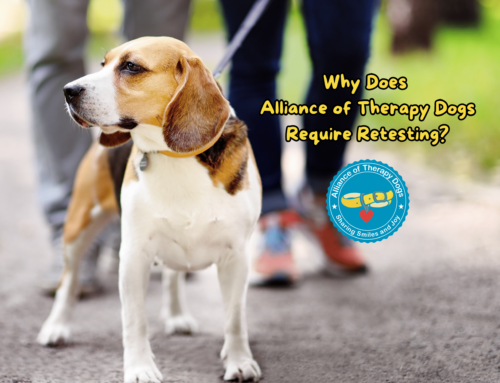As one of the largest therapy dog organizations in the U.S., we get questions about whether a therapy dog is the same as a service dog. Each of these dogs has a very different job from the others and the terms are not interchangeable. In this article, we explain the differences between therapy dogs and service dogs and we explain the roles these dogs play in the lives of those who need them.
What is a Service Dog?
Service Dogs are trained to perform tasks and to do work that eases their handlers’ disabilities. Working as part of a team with their disabled partners, service dogs help them attain safety and independence. It is very important to note that these dogs are not for petting as it could prevent them from performing their job correctly. Most service dogs have a “no petting” policy established by their owners.
The Americans with Disabilities Act (ADA) protects the rights of people with disabilities to be accompanied by their service dogs in public places such as restaurants, grocery stores, and hotels. Additional laws such as the Department of Transportation’s Air Carrier Access Act, the Housing and Urban Development’s Fair Housing Act, and the Federal Rehabilitation Act protect the rights of people with disabilities to be accompanied by their service animals in a wide variety of circumstances under which the ADA may not be applicable.
What is a Therapy Dog?
Therapy dogs also receive training but have a completely different type of job from service dogs. Their responsibilities are to provide psychological or physiological therapy to individuals other than their handlers. These dogs have stable temperaments and friendly, easy-going personalities. Typically, they visit hospitals, schools, hospices, nursing homes, and more. Unlike service dogs, therapy dogs are encouraged to interact with a variety of people while they are on-duty including petting the therapy dog.
Therapy dogs may also visit schools, daycares, group homes, and rehabilitation centers. Their roles vary from dogs who give learning disabled children the confidence to read out loud, to actively participating in physical rehabilitation therapy. In some cases, a therapy dog will work in an establishment exclusively, such as a psychotherapy practice.
Therapy dogs may be trained by just about anyone, but must meet set standards to be dog certification and registration and actively participate in the program. They are usually handled by their owners, but in some cases of Animal Assisted Therapy, the therapy dog may be handled by a trained professional.
Do Service Dogs and Therapy Dogs Have the Same Legal Status?
Despite thorough training, registration and the therapeutic benefits therapy dogs provide, they do not have the same jobs or legal designation as service dogs. While some institutions offer therapy dogs access on a case-by-case for the benefit of patients, guests, customers, or clientele, the handlers or owners of therapy dogs do not have the same rights to be accompanied by these dogs in places where pets are not permitted.
Service and therapy dogs provide much more than “jobs” for the disabled. Each of these animals provides their owners with the companionship and love that only a dog can give. To learn more about registering a therapy dog, please visit our new members page here.






